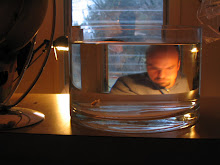 In more than 20 years of studying (in an admittedly on-again, off-again manner) the art of the Italian Renaissance, I've never really felt that I understood the great pastoral paintings of Giorgione or Titian. You know the type: handsome youths and nude nymphs reclining under trees, in sprawling meadows, with no clear aim in sight. Don't these people have shopping to do? I wondered, in the back of my mind. And, even if not, don't they eventually tire of hearing that same set of 16th-century standards on the lute?
In more than 20 years of studying (in an admittedly on-again, off-again manner) the art of the Italian Renaissance, I've never really felt that I understood the great pastoral paintings of Giorgione or Titian. You know the type: handsome youths and nude nymphs reclining under trees, in sprawling meadows, with no clear aim in sight. Don't these people have shopping to do? I wondered, in the back of my mind. And, even if not, don't they eventually tire of hearing that same set of 16th-century standards on the lute?I wonder no more. On a summery afternoon last week, weighed down by a cold and feeling a bit overwhelmed by the rote pressures of work, I rolled Cleo out to the large open tract that stands about a hundred yards from our house, and which is the result of the historic 1972 flood, which destroyed several houses. Once the home of families, it's now home to a few daffodils, a stand of dandelions, a couple of rabbits, and a community of vocal robins.
We threw down a quilt, and simply lolled. Cleo looked about, perhaps slightly stunned by the July-like heat, and I lay on my back. Eventually I took her over to a tree swing, and we ranged back and forth in lazy arcs. She leafed, distractedly, through a tiny board book. Maybe we made a few raspberries.
It wasn't a long stay; I think we were only on the quilt for about a half hour. But, boy, it was nice. Nice enough, in fact, that it seemed a pleasure worth commemorating in an oil painting. And, with that realization, I reached a tentative peace with the pastoral as genre. It's not, perhaps, a band of art that appeals to us when distracted. Appointments, duties, scores: such things can make the melody of a lute seem patently ridiculous. And yet, when we put away our temporary cares, the same melody can seem a siren song. Pastorals may seem like the residue of pleasures past, or the promise of pleasures possible: in either event, I'm now more alert to their charm.
It wasn't a long stay; I think we were only on the quilt for about a half hour. But, boy, it was nice. Nice enough, in fact, that it seemed a pleasure worth commemorating in an oil painting. And, with that realization, I reached a tentative peace with the pastoral as genre. It's not, perhaps, a band of art that appeals to us when distracted. Appointments, duties, scores: such things can make the melody of a lute seem patently ridiculous. And yet, when we put away our temporary cares, the same melody can seem a siren song. Pastorals may seem like the residue of pleasures past, or the promise of pleasures possible: in either event, I'm now more alert to their charm.




No comments:
Post a Comment